

PAGE TEN
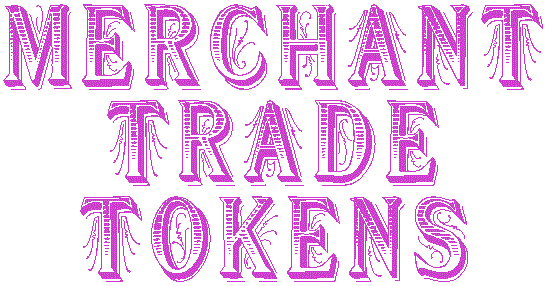
By Jerry Adams
Copyright © 1998, all rights reserved
EARLY TEXAS TOKENSAlthough some claim the earliest use of merchant trade tokens was in Roman times, the earliest use of trade tokens in Texas was probably by merchants in the 1870’s. I have seen no evidence of trade token use in Texas prior to 1870. Beer and liquor saloons were some of the first establishments in Texas to make use of tokens. The "two for a quarter" deal was very popular for liquor in most saloons. A single drink of whiskey cost 15¢, but if the customer was willing to accept a token in his change he was given a chip "Good for 12 ½¢ in Trade", or "Good for One Drink." This assured the saloon owner that the customer would return to his saloon for the next drink. The 2 ½¢ token was also used with a silver dime, in a similar manner.
Saloon beer tokens had different denominations, when keg beer sold for two glasses of beer for 15¢, required a 7 ½¢ token for change. The "four for a quarter" beer deal required a 6 ¼¢ token. So many different denomination tokens were required just in the saloon business.
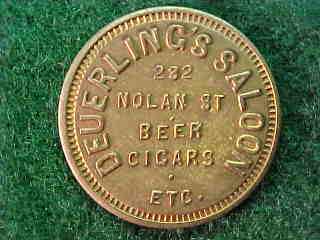
The daily monetary usage in Texas included the Mexican 8 reales piece, and the Spanish milled dollar well into the 1870’s. As is generally known, these coins were often cut into halves, quarters, and eighths, thus giving rise to the phrase "two bits" and "four bits." Some tokens are seen that borrow that usage for the 12 ½¢ denomination, substituting the phrase "one bit", or picturing a horse bit. These pictorial tokens are highly sought after.
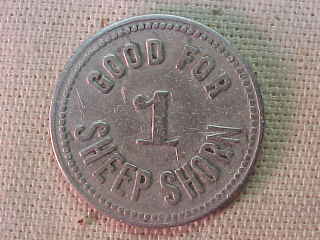
The Edwards Plateau area of southwest Texas, in the general area of Sanderson, Del Rio, Langtry, and Uvalde, is sheep country. This high and dry area is well suited to sheep ranching, and much Mexican influence is seen in both the culture of sheep shearing and the tokens. The heads of the shearing crews are called "Capitans", and the operations are called "trasquilas." As is the practice in other parts of the world (including New Mexico and Uruguay) tokens were used to track the number of sheep shorn by shearers (or tacinques), one token for each sheep shorn. As work progressed, the tacinque traded in his 25 single tokens for one that read "good for 25 sheep", or his 50 tokens for a "good for 50 sheep" token. There were even special tokens for bucks, because they were harder to handle, and the shearer was paid more for them. Many Mexican-American names are seen on these tokens, including Marquez, Rubio, Perez, Castro, and Reyes.
LUMBER TOKENSLumber tokens were used extensively in the eastern portion of Texas, throughout the piney woods north of Houston, up through Marshall, and north and west of Beaumont. Company tokens were generally used as a means of pay for employees, and were accepted as cash at the local company store. Often these tokens were issued in advance of pay, a form of credit, and deducted from the employee’s pay each month. The tokens also aided in bookkeeping, and were of vast benefit to the lumber company, rather than the employee. Texas lumber companies that issued tokens include the Thompson Tucker Lumber Company, the Texas Long Leaf Lumber Company, C. Bender and Sons, Boettcher Lumber Company, and Dacus Lumber Company, among many others.
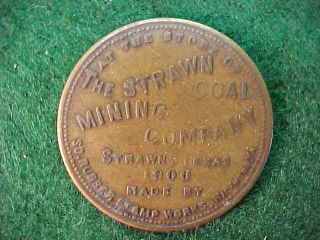
The usage of coal as fuel in 19th century America, as fuel for railroads, and in home and industry, created a need for coal tokens. Some of the towns in Texas that coal tokens are known, include Bridgeport, Strawn, Thurber, and Eagle Pass. Most coal company tokens come from the states of West Virginia, and Kentucky, although most states are known to have some. Edkins first edition (1977) Catalogue of United States Coal Company Scrip, lists more than 10,000 different coal tokens. Coal scrip token collectors are just one branch of the merchant token collecting family, and they are a highly dedicated group, and have given much back to the hobby.
GENERAL STORE TOKENS
The most often encountered trade token is the general store, or general merchant token. Most small towns in America, from Oklahoma to South Dakota, had a general store in the 1880’s and 1890’s. The pioneer merchants included bakers, dry goods merchants, grocers, and general stores. These were a thrifty people, and they discovered that the use of "trade tokens" gave them a slight advantage over a competitor who did not use the chips. Various methods were used to entice business. One was to hand out small denomination tokens to the children, who would undoubtedly bring their parents to the store when the child wanted to purchase a penny’s worth of candy. Another very common practice was for the merchant to buy eggs, poultry, garden and farm produce from the local inhabitants, and pay 10 percent more in tokens, than he would in cash. This ensured that the seller would return to his store to buy needed items, and conserved the merchant’s cash. Other merchants used the tokens as a bookkeeping device, advancing the customer a fixed sum in tokens, to be repaid when the customer sold his cotton, or cattle. General store merchant trade tokens are often found in denominations of 1¢, 5¢, 10¢, 25¢, 50¢, and $1.00. Rarely are they found with higher denominations.
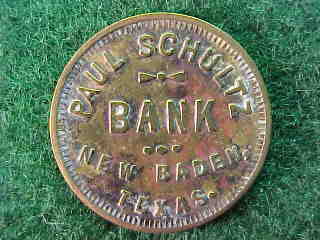
In the late 1800’s, many merchants were first or second generation Americans and their ties to their original homelands was strong, as shown by the names of the towns they settled. In Texas we have New Baden, Manheim, Schulenburg, Walburg, Weimer, New Braunfels, and Nordheim. Many times, the merchant name on a token also speaks of his/her homeland. Some of the merchant names seen on Texas tokens include Hruska, Oltjen, Schmidt, Vogel, Hempel, Boettcher, Drodz, Umland, and Escajeda.
HOW TRADE TOKENS WERE MADE
The production of tokens is a complicated affair, and in this description I will try to be succinct. Engravers and diesinkers make tokens. First planchets, or blanks are cut into the approximate size and shape of the token, from strips of metal about a foot long. The planchets are cut using a "cutting machine", as the strips are handfed into the machine. The planchets are then struck by dies, in a "coining press." The manufacture of the dies, is the heart of the token manufacturing process. Two methods of making the dies were often used. The first was direct engraving of the die. This method involved softening a tool steel cylinder by annealing, then engraving (in reverse and incuse) into the metal. Then the metal was hardened and used as a die to stamp the softer brass or aluminum planchets. The second method, called "hubbing", involved carving into a softened tool steel cylinder in relief, the design, and then hardening the cylinder and using it as a "master" die, to make incuse dies, which were used to stamp the brass or aluminum planchets. In recent years, a third process was added, involving a "transfer-reducing" machine, in which a large model of the face was made, and the machine reduced the model to the final die size. This method is most often used for medals, and coins however, not for tokens. The coining press varied, over the years and from one manufacturer to the next.
DIESINKERS AND MANUFACTURERSIt would be impractical for me to try to list every token manufacturer in the United States from 1870 through 1950. For that reason, I will list some of the token manufacturers, but include the caveat that this list is by no means inclusive.
Northwestern Stamp Works, St. Paul, MN |
James J. Murdock, Cincinnati, OH |
So. Rub. St. Wks, Richmond, Va. |
So. St. & Sta. Co, Richmond, VA |
S.M. Spencer Mfg. Co, Boston |
Moise-Klinkner, San Francisco, CA |
San Jose Rubber Stamp Works |
Quincy Calglesser Rubber Stamp Wks. |
Pacific Coast Stamp Wks. Seattle |
Wendall's, Minneapolis, MN |
Wright & Co, Cincinnati, OH |
Puget Sound Stamp Works |
C. H. Hanson, Chicago, IL |
Orco, Metal Scrip |
Insurance Credit System |
Ingle-Schierloh, Co |
Ingle System |
Osborne Register Co. |
S.D. Childs Co. Chicago, IL |
Dayton Stencil (H. Rice) |
Dorman, Baltimore, MD |
S.H. Quints, Philadelphia, PA |
Greenduck, Chicago, IL |
A.W. Hammer |
Meyer & Wenthe, Chicago |
Pannier Bros., PIttsburgh, PA |
R&S Engraving & Dieworks, Chicago |
Salt Lake Stamp Co. |
Henry Rice, Dayton, OH |
Heideman Mfr. Co., San Antonio |
Barnard Stamp Co, St. Louis |
E.A. Schmidt Co. St. Louis |
Schaaf, Minneapolis, MN |
J.M. Brunswick Co. |
Brunswick-Balke Co. |
Brunswick-Balke-Collender Co. |
| Excelsior, St. Louis | Haskell Eng. Co., St. Louis |
A.E. Schmidt Co., St. Louis |
Orco Systems |
Koken Barber Supply, St. Louis |
Chas. Pick & Co. |
R. Rothchild & Son |
Los Angeles Rubber Stamp Co. |
Aug. Kern Barber Supplies,St. Louis |
B. Riley Hauk, St. Louis |
Dallas Engraving Co, Dallas, TX |
Jacob Strahle & Co., San Francisco |
Patrick & Co., San Francisco |
back to page 1 of our token web pages...
...on to page 11 of our token web pages....
updated 5 feb 2000